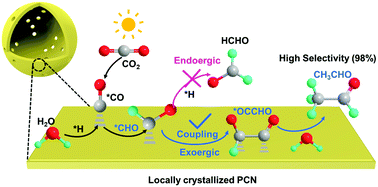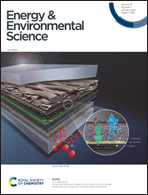Regulating the *OCCHO intermediate pathway towards highly selective photocatalytic CO2 reduction to CH3CHO over locally crystallized carbon nitride†
Abstract
Photocatalytic conversion of CO2 to CH3CHO is of increasing interest but confronts the significant challenges of forming C–C bonds and keeping the C![[double bond, length as m-dash]](https://www.rsc.org/images/entities/char_e001.gif) O bond intact throughout the process. Here, we report the selective photocatalytic hydrogenation of CO2 to CH3CHO using a modified polymeric carbon nitride (PCN) under mild conditions. The locally crystallized PCN offers a photocatalytic activity of 1814.7 μmol h−1 g−1 with a high selectivity of 98.3% for CH3CHO production and a quantum efficiency of 22.4% at 385 nm, outperforming all the state-of-art CO2 photocatalysts. The promoted formation of the *OCCHO intermediate on the locally crystallized PCN is disclosed as the key factor leading to the highly selective CH3CHO generation. The locally crystallized PCN favors spontaneous C–C coupling towards *OCCHO formation rather than *CHO protonation, thus preventing HCHO formation. This work provides a new strategy for designing carbon nitrides for highly selective and sustainable conversion of CO2 to CH3CHO.
O bond intact throughout the process. Here, we report the selective photocatalytic hydrogenation of CO2 to CH3CHO using a modified polymeric carbon nitride (PCN) under mild conditions. The locally crystallized PCN offers a photocatalytic activity of 1814.7 μmol h−1 g−1 with a high selectivity of 98.3% for CH3CHO production and a quantum efficiency of 22.4% at 385 nm, outperforming all the state-of-art CO2 photocatalysts. The promoted formation of the *OCCHO intermediate on the locally crystallized PCN is disclosed as the key factor leading to the highly selective CH3CHO generation. The locally crystallized PCN favors spontaneous C–C coupling towards *OCCHO formation rather than *CHO protonation, thus preventing HCHO formation. This work provides a new strategy for designing carbon nitrides for highly selective and sustainable conversion of CO2 to CH3CHO.

- This article is part of the themed collection: SDG12: Sustainable production of energy materials


 Please wait while we load your content...
Please wait while we load your content...